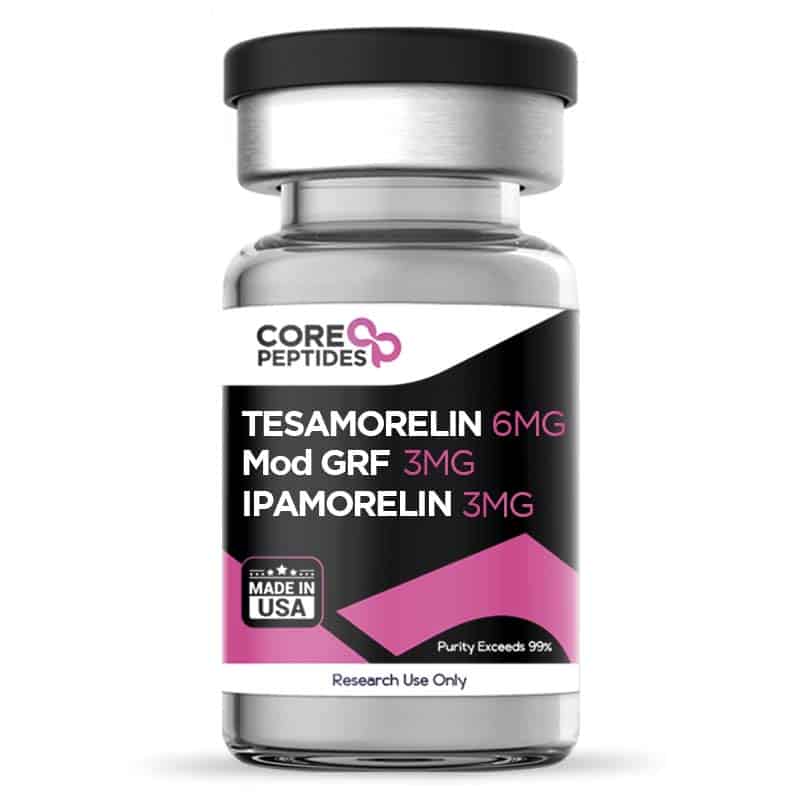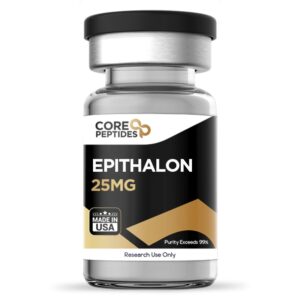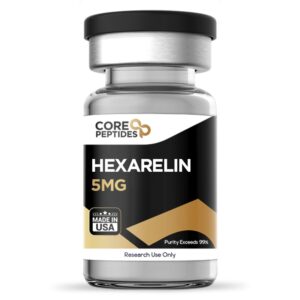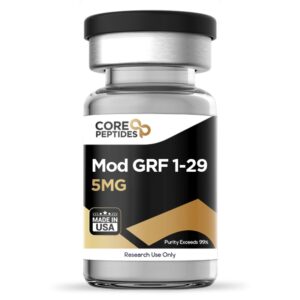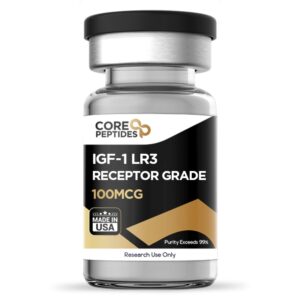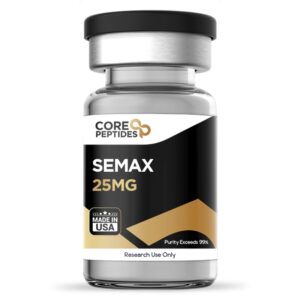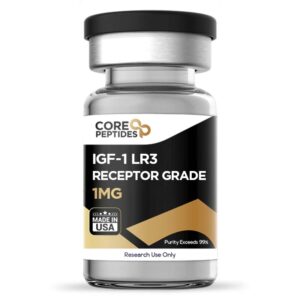Tesamorelin & CJC-1295 (Mod GRF 1-29) & Ipamorelin Blend (12mg)
$117.00
Size: 12mg
Contents: Tesamorelin (6mg) & CJC-1295 (Mod GRF 1-29) (3mg) & Ipamorelin (3mg)
Form: Lyophilized powder
Purity: >99%
SKU: TESA-MOD-GRF-IPA-12MG
FREE Shipping on $200+ orders
Discount per Quantity
| Quantity | Discount | Price |
|---|---|---|
| 5 - 8 | 5% | $111.15 |
| 9 + | 10% | $105.30 |
Tesamorelin & CJC-1295 (Mod GRF 1-29) & Ipamorelin Peptide Blend
Tesamorelin & CJC-1295 (Mod GRF 1-29) & Ipamorelin are all synthetic peptides which, albeit via different proposed mechanisms, have exhibited potential to stimulate growth hormone (GH) synthesis and secretion.
Tesamorelin, a synthetic analogue of the growth hormone-releasing hormone (GHRH), appears to act by specifically stimulating the production and release of endogenous growth hormone (GH) due to its potential binding affinity for GHRH receptors. Structurally, Tesamorelin is a chain of 44 amino acids, containing a sequence that bears resemblance to GHRH. Intriguingly, modifications have been introduced to Tesamorelin to possibly fortify its defense against enzymatic breakdown. For instance, its C-terminus showcases a trans-3-hexenoic acid group alteration, a change sometimes referred to as an omega-amino acid modification, which is suggested to bolster the peptide's resilience to enzymatic degradation. Further, Tesamorelin's N-terminus is adorned with an acetyl group (CH₃CO-), a modification that might further amplify the molecule's stability and biological efficacy. Consequently, this peptide garners the designation N-(trans-3-hexenoyl)-[Tyr1]hGRF(1–44)NH2 acetate. When engaging with GHRH receptors located in regions like the pituitary and hypothalamus, it is theorized that Tesamorelin may stimulate the secretion of HGH from the resident pituitary cells.
CJC-1295 (Mod GRF 1-29) is a synthetic peptide that appears to exhibit prolonged half-life as it is likely to resist enzymatic degradation. It is also known as CJC-1295 without DAC (Drug Affinity Complex). References suggest it as a tetrasubstituted variant of the shortest functional GHRH sequence, denoted GRF (1-29). Consequently, it is posited that this molecule may potentially engage with GHRH receptors on pituitary cells, possibly influencing the release of hGH. Research indicates that the peptide appears to act as a potent stimulator of GH secretion, similar to GHRH, which may show promise in promoting protein synthesis, muscle growth, and enhanced metabolic processes.
Ipamorelin, a synthetic pentapeptide, appears to act as a selective agonist for the ghrelin receptor and may stimulate the release of GH. This is because ghrelin receptors are found in the pituitary gland, where they are called growth hormone secretagogue (GHS) receptors. It appears to display high specificity and minimal action on other hormonal systems, making it a target for research in GH stimulation.
Chemical Makeup (1)(2)(3)
Molecular Formula:
- Tesamorelin: C221H366N72O67S
- CJC-1295 (Mod GRF 1-29): C152H252N44O42
- Ipamorelin: C38H49N9O5
Molecular Weight:
- Tesamorelin: 5136 g/mol
- CJC-1295 (Mod GRF 1-29): 3367.9 g/mol
- Ipamorelin: 711.8 g/mol
Sequence
- Tesamorelin: Unk-Tyr-Ala-Asp-Ala-Ile-Phe-Thr-Asn-Ser-Tyr-Arg-Lys-Val-Leu-Gly-Gln-Leu-Ser-Ala-Arg-Lys-Leu-Leu-Gln-Asp-Ile-Met-Ser-Arg-Gln-Gln-Gly-Glu-Ser-Asn-Gln-Glu-Arg-Gly-Ala-Arg-Ala-Arg-Leu-NH2
- CJC-1295 (Mod GRF 1-29): L-tyrosyl-D-alanyl-L-alpha-aspartyl-L-alanyl-L-isoleucyl-L-phenylalanyl-L-threonyl-L-glutaminyl-L-seryl-L-tyrosyl-L-arginyl-L-lysyl-L-valyl-L-leucyl-L-alanyl-L-glutaminyl-L-leucyl-L-seryl-L-alanyl-L-arginyl-L-lysyl-L-leucyl-L-leucyl-L-glutaminyl-L-alpha-aspartyl-L-isoleucyl-L-leucyl-L-seryl-L-argininamide
- Ipamorelin: alpha-methyl-alanyl-L-histidyl-3-(2-naphthyl)-D-alanyl-D-phenylalanyl-L-lysinamide
Other Known Titles
- CJC-1295 (Mod GRF 1-29): CJC 1295 with DAC
- Ipamorelin: Ipamorelin Acetate
Research and Clinical Studies
Tesamorelin & CJC-1295 (Mod GRF 1-29) & Ipamorelin Blend and the Pituitary Gland
The Tesamorelin & CJC-1295 (Mod GRF 1-29) & Ipamorelin peptide blend appear to exhibit significant interactions with the pituitary gland, seemingly exerting potential impact through specific receptor binding and subsequent modulation of growth hormone (GH) release.
Tesamorelin & CJC-1295 (Mod GRF 1-29) appear to engage with GHRH receptors through intricate molecular processes, potentially initiating various signaling pathways. Upon interaction with the GHRH receptor, it is posited that Tesamorelin & CJC-1295 (Mod GRF 1-29) may cause shifts in receptor configuration, possibly instigating intracellular communication channels.(4) There is suggestion amongst researchers that Tesamorelin & CJC-1295 (Mod GRF 1-29) might promote the generation of cyclic adenosine monophosphate (cAMP) within specific target cells. This may potentially be facilitated by the activation of adenylate cyclase, which might transform ATP to cAMP. Elevated cAMP levels are believed to possibly activate protein kinase A (PKA), a molecule that appears integral to intracellular signaling. PKA might then phosphorylate a range of target proteins, setting off subsequent cellular reactions. The hypothetical activation of the GHRH receptor by Tesamorelin & CJC-1295 (Mod GRF 1-29), coupled with the proposed cAMP-PKA signaling sequence, may stimulate hGH production and dispersal from somatotrophs located in the pituitary gland. The HGH secreted from these cells may also play a role in the formation of insulin-like growth factor-1 (IGF-1).(5)
CJC-1295 (Mod GRF 1-29) peptide has four amino acid substitutions in its structure, which appears to enhance its GH-related activity as well as its potential resistance towards the proteolytic enzymes. These modifications are also believed to assist “at least 90% of the peptide” to bind covalently to blood albumin, with trace amounts potentially binding to fibrinogen and immunoglobulin G (IgG).(5)
As per the researchers, “No other chemical species have been found bound to DAC-GRF after administration This binding extends the half-life of the active pharmacophore, resulting in a markedly prolonged duration of action in several animal species.”(5)
Ipamorelin, on the other hand, appears to act as a selective agonist for the GHS (ghrelin) receptor, which is also present on somatotrophs within the pituitary gland. Its binding to GHS (ghrelin) receptors is believed to induce GH release with high specificity and minimal impact on other hormonal systems. Research-based outcomes have indicated that Ipamorelin influence in certain test models may lead to increased GH secretion, without significantly affecting prolactin, or ACTH levels.(6) In vitro analyses indicate that Ipamorelin's interaction with GHS receptors possibly influences somatotroph cells within the anterior pituitary gland. This interaction appears to initiate a series of intracellular signaling cascades. One posited mechanism is the activation of phospholipase C (PLC), which, according to some researchers, might subsequently facilitate the release of inositol triphosphate (IP3) and diacylglycerol (DAG). IP3 might then prompt the release of calcium ions (Ca2+) from intracellular reserves, whereas DAG potentially activates protein kinase C (PKC). Such elevation in intracellular calcium and the probable activation of PKC are suggested to culminate in the observed exocytosis of vesicles containing growth hormone from pituitary cells.(7)
Tesamorelin & CJC-1295 (Mod GRF 1-29) & Ipamorelin Blend and the GI Tract
Ipamorelin is believed to primarily interact with the ghrelin receptor within the GI tract. Upon binding to the ghrelin receptors, Ipamorelin may elicit a variety of responses including promoting gut motility and improving intestinal absorption. Moreover, Ipamorelin has shown promise in attenuating inflammation and promoting tissue repair in various models of GI injury. As per researchers, Ipamorelin may “increase total body fat percentages” , identifying the peptide as a “potent and selective stimulator of GH that can significantly influence the GI system, body composition, and adiposity.”(6) Investigators explored the potential impacts of Ipamorelin on gastric functions, contrasting its effects with a placebo. They were particularly interested in its suggested ability to hasten gastric emptying. To assess this, they utilized a method that monitored leftover radioactivity in the stomach a quarter-hour after introducing a particular substance via intragastric gavage. It appears that abdominal surgeries might potentially slow down gastric emptying, an effect that was notably evident in the placebo group. In comparison, Ipamorelin seemed to accelerate this process. Such findings hint at Ipamorelin's potential to boost the pace of gastric emptying. Further, the group aimed to understand how this compound influenced the contractile behavior of gastric smooth muscles when exposed to acetylcholine and electrical field stimulation. Information gathered indicated that intestinal surgeries might notably reduce the contractile reactions to these simulations. However, this suppression appeared to be lessened when Ipamorelin was combined with ghrelin. This raises the possibility that Ipamorelin may not only promote gastric muscle contractility but also possibly offset the inhibitory effects resulting from certain surgical procedures. (8)
Synergistic Action of Tesamorelin & CJC-1295 (Mod GRF 1-29) & Ipamorelin Blend
The rationale for combining these peptides lies in their supposed distinct mechanisms of action and potential to enhance growth hormone (GH) secretion synergistically. The apparent synergy of all these peptides lies in their individual potential to increase lean mass and muscle growth.
For example, a recent scientific investigation proposed that the potential impacts of Tesamorelin on muscle tissue integrity may be examined using CT scans. Following a placebo-controlled experiment, the CT-scan findings suggest a possible association between Tesamorelin and improvements in muscle density and size. Notably, some muscle groups, especially the rectus abdominis, psoas major, and paraspinal muscles, reportedly showed more evident changes. These changes were characterized by either an increase in muscle size and density or a reduction in fat content. Statistically, these alterations were different compared to the placebo group. Although some theorize that Tesamorelin's effects might be related to molecules like IGF-1, the study did not find a notable connection between changes in IGF-1 levels and shifts in muscle size or density.(9)
Further, preliminary research involving CJC-1295 (Mod GRF 1-29) 1-29 indicates a potential rise in nocturnal growth hormone levels, as well as serum levels of IGF-I and IGFBP-3, and GHBP concentrations.(10) Consequently, male research models exposed to the peptide over a span of four months seemingly gained an average of 1.26 kg in lean body mass. Additionally, research suggests that the peptide might influence an increase in skin thickness among males and may possibly enhance insulin sensitivity.
Similarly, preliminary studies have suggested that Ipamorelin might exhibit effects similar to those seen with Tesamorelin concerning skeletal muscle and bone structures. However, these findings are still awaiting further confirmation. Going further, there is a working hypothesis amongst researchers that Ipamorelin may interact with, and possibly increase, IGF-I levels. These interactions appeared to align with an increase in muscle fiber size, overall muscle mass, and hence, a potential boost in skeletal muscle strength during this mouse-based study.(11)
Tesamorelin & CJC-1295 (Mod GRF 1-29) & Ipamorelin blend is available for research and laboratory purposes only. Please review and adhere to our Terms and Conditions before ordering.
References:
- National Center for Biotechnology Information (2023). PubChem Compound Summary for CID 9831659, Ipamorelin. https://pubchem.ncbi.nlm.nih.gov/compound/Ipamorelin.
- National Center for Biotechnology Information (2023). PubChem Compound Summary for CID 56841945. https://pubchem.ncbi.nlm.nih.gov/compound/56841945.
- National Center for Biotechnology Information (2023). PubChem Compound Summary for CID 16137828, Tesamorelin. https://pubchem.ncbi.nlm.nih.gov/compound/Tesamorelin.
- Spooner, L. M., & Olin, J. L. (2012). Tesamorelin: a growth hormone-releasing factor analogue for HIV-associated lipodystrophy. The Annals of pharmacotherapy, 46(2), 240–247. https://doi.org/10.1345/aph.1Q629
- Zhou, F., Zhang, H., Cong, Z., Zhao, L. H., Zhou, Q., Mao, C., Cheng, X., Shen, D. D., Cai, X., Ma, C., Wang, Y., Dai, A., Zhou, Y., Sun, W., Zhao, F., Zhao, S., Jiang, H., Jiang, Y., Yang, D., Eric Xu, H., ... Wang, M. W. (2020). Structural basis for activation of the growth hormone-releasing hormone receptor. Nature communications, 11(1), 5205. https://doi.org/10.1038/s41467-020-18945-0
- Sinha DK, Balasubramanian A, Tatem AJ, Rivera-Mirabal J, Yu J, Kovac J, Pastuszak AW, Lipshultz LI. Beyond the androgen receptor: the role of growth hormone secretagogues in the modern management of body composition in hypogonadal males. Transl Androl Urol. 2020 Mar;9(Suppl 2):S149-S159. doi: 10.21037/tau.2019.11.30. PMID: 32257855; PMCID: PMC7108996 https://www.ncbi.nlm.nih.gov/pmc/articles/PMC7108996/
- Jiménez-Reina, L., Cañete, R., de la Torre, M. J., & Bernal, G. (2002). Influence of chronic treatment with the growth hormone secretagogue Ipamorelin, in young female rats: somatotroph response in vitro. Histology and histopathology, 17(3), 707–714. https://doi.org/10.14670/HH-17.707
- Greenwood-Van Meerveld, B., Tyler, K., Mohammadi, E., & Pietra, C. (2012). Efficacy of ipamorelin, a ghrelin mimetic, on gastric dysmotility in a rodent model of postoperative ileus. Journal of experimental pharmacology, 4, 149–155. https://doi.org/10.2147/JEP.S35396
- Adrian S, Scherzinger A, Sanyal A, Lake JE, Falutz J, Dubé MP, Stanley T, Grinspoon S, Mamputu JC, Marsolais C, Brown TT, Erlandson KM. The Growth Hormone Releasing Hormone Analogue, Tesamorelin, Decreases Muscle Fat and Increases Muscle Area in Adults with HIV. J Frailty Aging. 2019;8(3):154-159. doi: 10.14283/jfa.2018.45. PMID: 31237318; PMCID: PMC6766405. https://www.ncbi.nlm.nih.gov/pmc/articles/PMC6766405/
- Khorram, O., Laughlin, G. A., & Yen, S. S. (1997). Endocrine and metabolic effects of long-term administration of [Nle27]growth hormone-releasing hormone-(1-29)-NH2 in age-advanced men and women. The Journal of clinical endocrinology and metabolism, 82(5), 1472–1479. https://doi.org/10.1210/jcem.82.5.3943
- Andersen, N. B., Malmlöf, K., Johansen, P. B., Andreassen, T. T., Ørtoft, G., & Oxlund, H. (2001). The growth hormone secretagogue ipamorelin counteracts glucocorticoid-induced decrease in bone formation of adult rats. Growth hormone & IGF research : official journal of the Growth Hormone Research Society and the International IGF Research Society, 11(5), 266–272. https://doi.org/10.1054/ghir.2001.0239
